Carbon offset programs offer a practical way for individuals and businesses to reduce their carbon footprint and support sustainable initiatives. This article explores the benefits of participation, including enhanced corporate social responsibility and compliance with environmental regulations. It also outlines common project types such as reforestation and renewable energy, provides steps for participation, and discusses regional differences and future trends in these programs. Understanding these aspects can empower more effective engagement in climate change mitigation efforts.
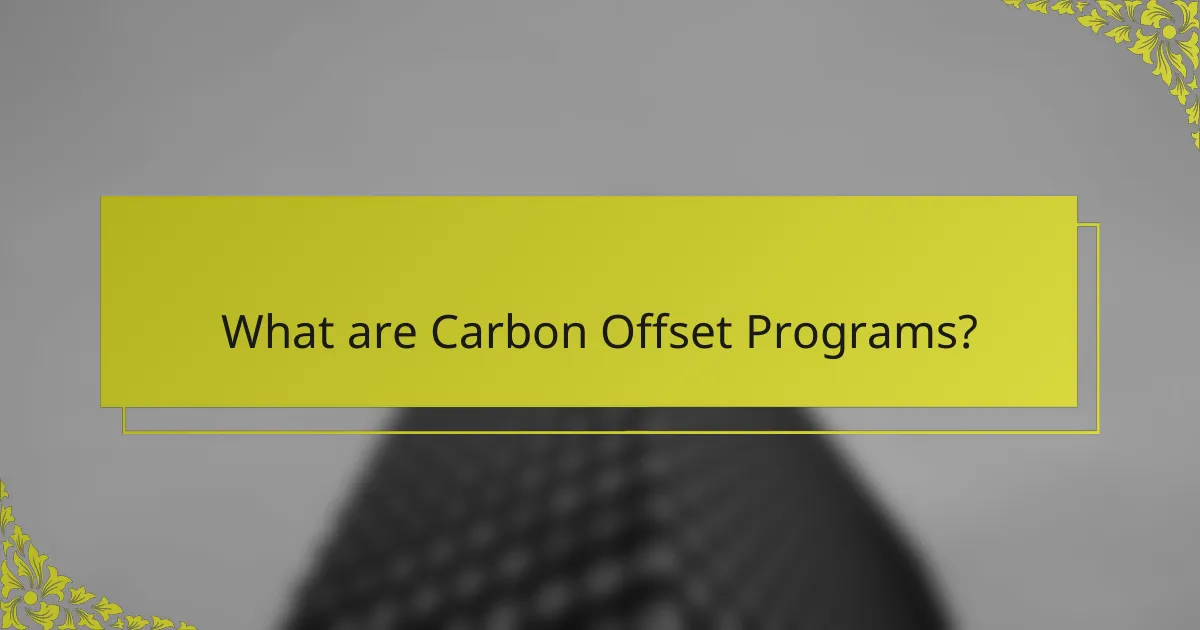
What are Carbon Offset Programs?
Carbon offset programs are initiatives that allow individuals and businesses to compensate for their carbon emissions by investing in projects that reduce greenhouse gases. These programs often support renewable energy, reforestation, and energy efficiency projects. Participating in carbon offset programs can enhance corporate social responsibility and contribute to climate change mitigation. As a result, these efforts can lead to improved public perception and compliance with environmental regulations.
How do Carbon Offset Programs work?
Carbon offset programs work by allowing individuals and businesses to compensate for their carbon emissions by funding projects that reduce greenhouse gases. Participants purchase carbon credits, each representing a specific amount of carbon dioxide reduced or removed from the atmosphere. These credits support initiatives like reforestation, renewable energy, and energy efficiency improvements. As a result, carbon offset programs help mitigate climate change while promoting sustainable practices.
Why are Carbon Offset Programs important for sustainability?
Carbon offset programs are vital for sustainability as they help reduce greenhouse gas emissions. They enable individuals and organizations to counteract their carbon footprint by investing in projects that absorb or prevent emissions, such as reforestation and renewable energy initiatives. These programs not only promote environmental responsibility but also foster economic development in communities involved in sustainable practices. By participating in carbon offset programs, entities contribute to a global effort to combat climate change and support a healthier planet.
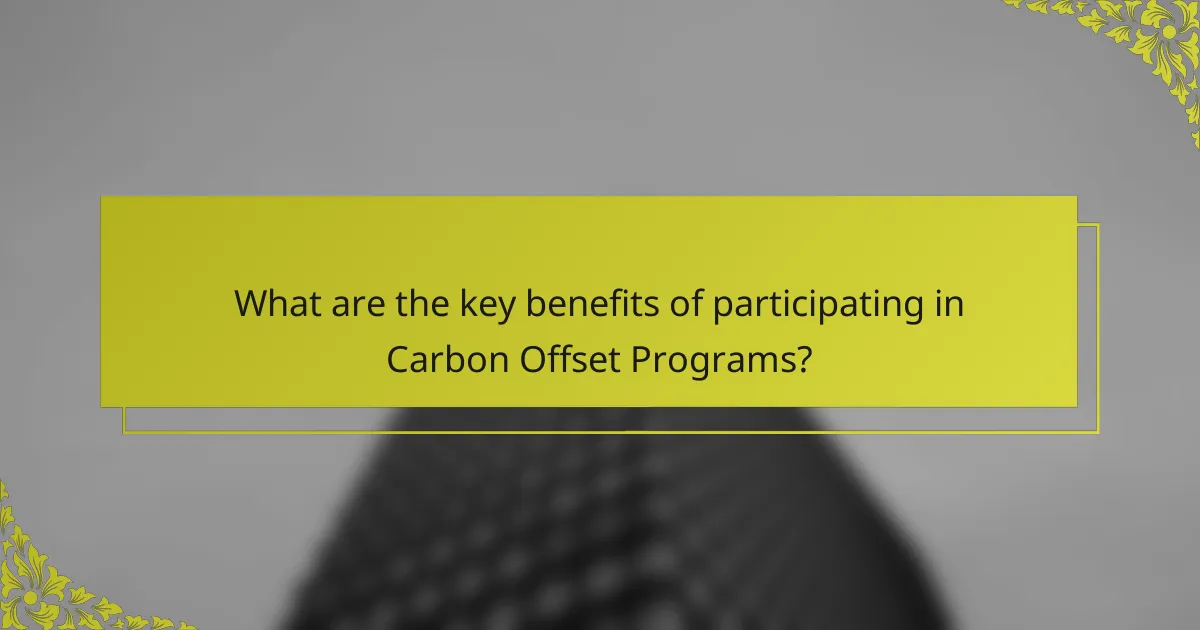
What are the key benefits of participating in Carbon Offset Programs?
Participating in Carbon Offset Programs offers several key benefits, including reducing carbon footprint, supporting sustainable projects, and enhancing corporate social responsibility. These programs help mitigate climate change by funding renewable energy, reforestation, and conservation efforts. As a result, participants contribute to a healthier planet while potentially improving their brand image. Engaging in these initiatives can also lead to financial incentives and compliance with environmental regulations.
How do Carbon Offset Programs contribute to climate change mitigation?
Carbon offset programs significantly contribute to climate change mitigation by funding projects that reduce greenhouse gas emissions. These initiatives include reforestation, renewable energy, and energy efficiency upgrades. By investing in such projects, individuals and businesses can effectively neutralize their carbon footprint, promoting a sustainable future. Additionally, carbon offset programs often support local communities, providing economic benefits while enhancing environmental resilience.
What financial incentives are available for participants in Carbon Offset Programs?
Participants in Carbon Offset Programs can access various financial incentives such as tax credits, grants, and carbon credits. These incentives encourage investment in sustainable practices and can significantly reduce overall project costs. For instance, purchasing carbon credits can provide direct financial returns while supporting environmental goals. Additionally, some programs may offer funding for renewable energy projects or energy efficiency improvements, enhancing both economic and ecological benefits.
How do Carbon Offset Programs enhance corporate social responsibility?
Carbon offset programs enhance corporate social responsibility by allowing companies to mitigate their environmental impact. These programs enable businesses to invest in projects that reduce greenhouse gas emissions, such as reforestation and renewable energy initiatives. As a result, companies demonstrate commitment to sustainability, improve their public image, and meet regulatory requirements. Furthermore, participation can lead to increased customer loyalty, as consumers increasingly favor environmentally responsible brands.
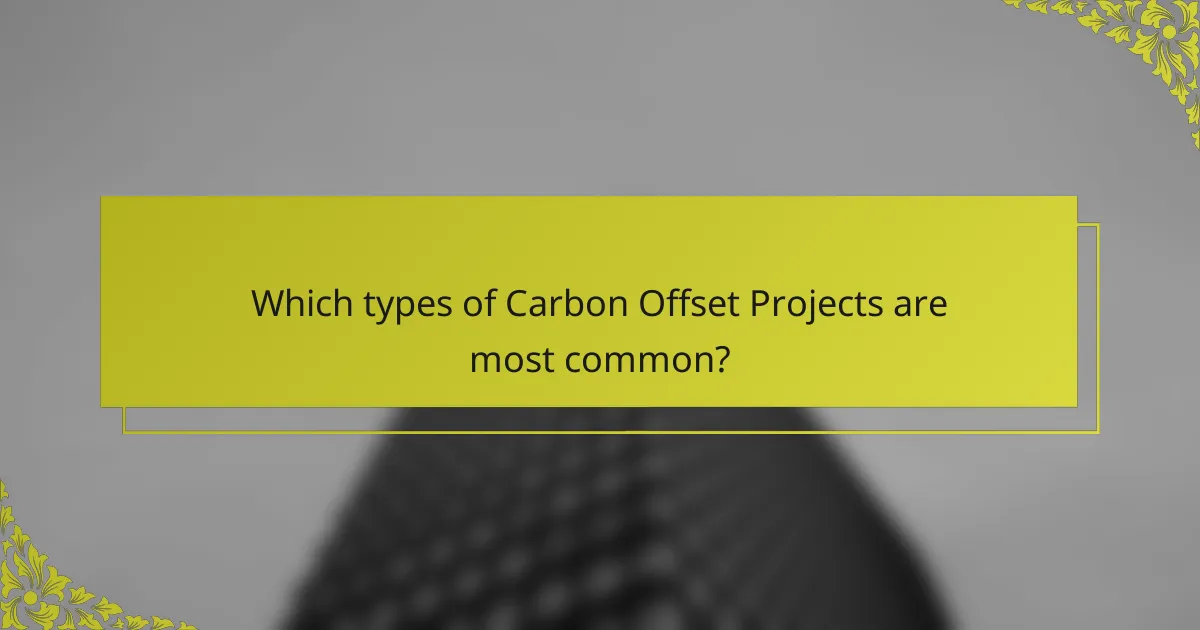
Which types of Carbon Offset Projects are most common?
The most common types of carbon offset projects include reforestation, renewable energy, energy efficiency, methane capture, and conservation. Each project type addresses specific carbon emissions while providing environmental benefits.
Reforestation projects focus on planting trees to absorb CO2, while renewable energy projects generate clean energy to replace fossil fuels. Energy efficiency projects improve energy use in buildings, reducing overall emissions. Methane capture projects prevent methane emissions from landfills or agricultural operations. Conservation projects protect existing ecosystems, preserving their carbon storage capabilities.
What are renewable energy projects in Carbon Offset Programs?
Renewable energy projects are integral to carbon offset programs, focusing on reducing greenhouse gas emissions. These projects include solar farms, wind energy installations, and biomass energy systems. They contribute to sustainability by generating clean energy while offsetting carbon footprints. Participants can invest in these projects to support environmental initiatives and receive carbon credits in return.
How do reforestation projects function as Carbon Offset initiatives?
Reforestation projects function as carbon offset initiatives by absorbing carbon dioxide from the atmosphere. They restore ecosystems, enhance biodiversity, and improve air quality. These projects can sequester significant amounts of carbon, with mature forests capturing up to 30% of global carbon emissions annually. Participation can involve funding, tree planting, or supporting organizations dedicated to reforestation efforts. By investing in these initiatives, individuals and businesses can effectively reduce their carbon footprints and contribute to climate change mitigation.
What role do community-based projects play in Carbon Offset Programs?
Community-based projects are essential in Carbon Offset Programs as they engage local stakeholders and promote sustainable practices. These projects often enhance biodiversity, improve local ecosystems, and provide economic benefits to communities. By involving residents, they ensure that offset initiatives are culturally relevant and effectively implemented. Moreover, community participation fosters awareness and education about climate change, leading to greater long-term commitment to carbon reduction efforts.
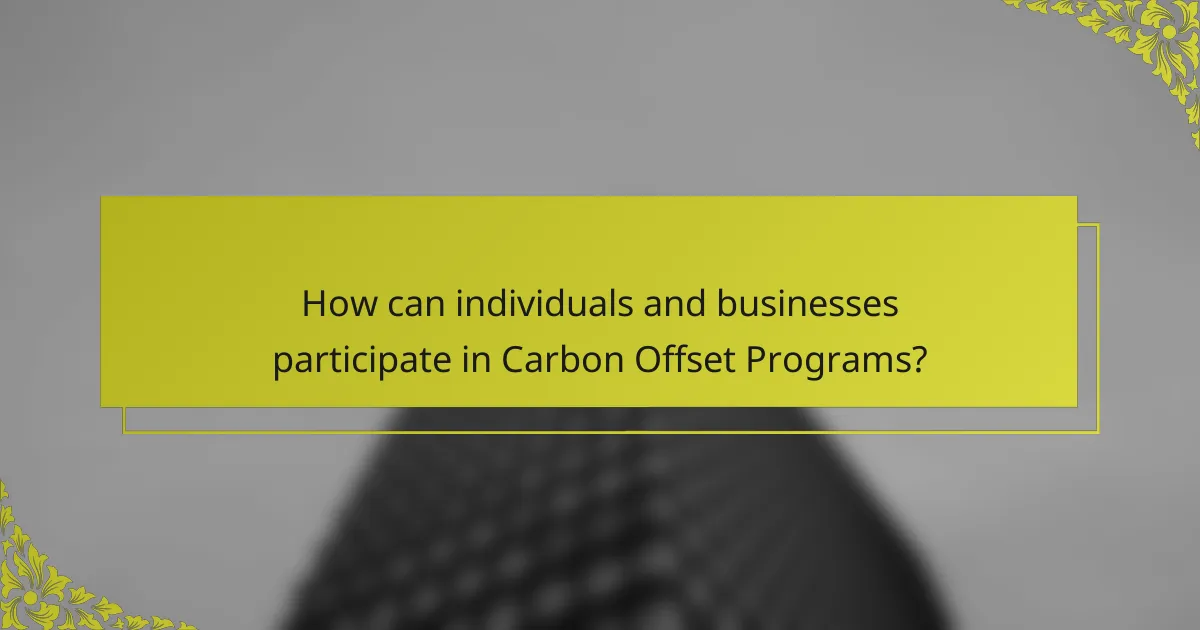
How can individuals and businesses participate in Carbon Offset Programs?
Individuals and businesses can participate in carbon offset programs by purchasing carbon credits or investing in sustainability projects. These programs allow participants to compensate for their carbon emissions by funding initiatives that reduce greenhouse gases.
1. Research available carbon offset programs that align with your values and goals.
2. Calculate your carbon footprint to determine how many credits you need.
3. Choose a reputable provider to purchase carbon credits from.
4. Consider supporting local environmental projects for direct community impact.
5. Monitor the effectiveness of your contributions and adjust as necessary.
What steps should individuals take to offset their carbon footprint?
To offset their carbon footprint, individuals should adopt specific actions like reducing energy consumption, using renewable energy, and participating in carbon offset programs.
1. Calculate your carbon footprint using online calculators.
2. Reduce energy use by improving home insulation and using energy-efficient appliances.
3. Opt for public transportation, biking, or walking instead of driving.
4. Support renewable energy by choosing green energy suppliers.
5. Participate in carbon offset programs to compensate for unavoidable emissions.
6. Plant trees or support reforestation projects to enhance carbon sequestration.
Which organizations offer Carbon Offset options for businesses?
Several organizations offer Carbon Offset options for businesses, including Climate Action Reserve, Gold Standard, and Verra. These organizations provide verified projects that help companies reduce their carbon footprint.
| Organization | Type of Projects Offered | Certification Standard |
|————————|———————————-|————————–|
| Climate Action Reserve | Forestry, renewable energy | CAR Standard |
| Gold Standard | Renewable energy, community projects | Gold Standard |
| Verra | Reforestation, energy efficiency | Verified Carbon Standard |
| American Carbon Registry | Land use, methane capture | ACR Standard |
| Carbon Trust | Energy efficiency, waste management | Carbon Trust Standard |
| Plan Vivo | Community-based forestry | Plan Vivo Standard |
How can businesses integrate Carbon Offset Programs into their operations?
Businesses can integrate Carbon Offset Programs by assessing their carbon footprint, selecting appropriate offset projects, and implementing strategies to fund these initiatives.
1. Evaluate current emissions to understand reduction targets.
2. Research credible carbon offset projects aligned with business values.
3. Invest in offsets that compensate for unavoidable emissions.
4. Communicate efforts to stakeholders to enhance brand image.
By following these steps, companies can contribute to sustainability while potentially enhancing their market position.

What challenges do Carbon Offset Programs face?
Carbon offset programs face challenges such as verification difficulties, limited public awareness, and varying regulatory standards. These issues hinder their effectiveness in achieving climate goals. For example, ensuring that offsets represent real, measurable emissions reductions can be complex. Additionally, inconsistent regulations across regions can complicate participation for businesses.
How do verification and transparency issues impact Carbon Offset Programs?
Verification and transparency issues significantly undermine the credibility of Carbon Offset Programs. These challenges can lead to skepticism among consumers and investors, ultimately reducing participation. Inadequate verification processes may result in inflated claims about carbon savings, making it difficult to assess the actual impact. As a result, organizations may struggle to build trust and demonstrate their commitment to sustainability. Enhanced transparency is essential for ensuring that projects deliver measurable benefits and align with environmental goals.
What common misconceptions exist about Carbon Offset Programs?
Common misconceptions about carbon offset programs include the belief that they allow for unlimited carbon emissions, that they are ineffective, and that they only benefit large corporations. Many think purchasing offsets fully compensates for personal emissions, neglecting the importance of reducing emissions at the source. Additionally, some believe these programs lack transparency, but many reputable ones provide detailed information about projects and their impacts. Understanding these misconceptions is crucial for effectively participating in carbon offset initiatives.
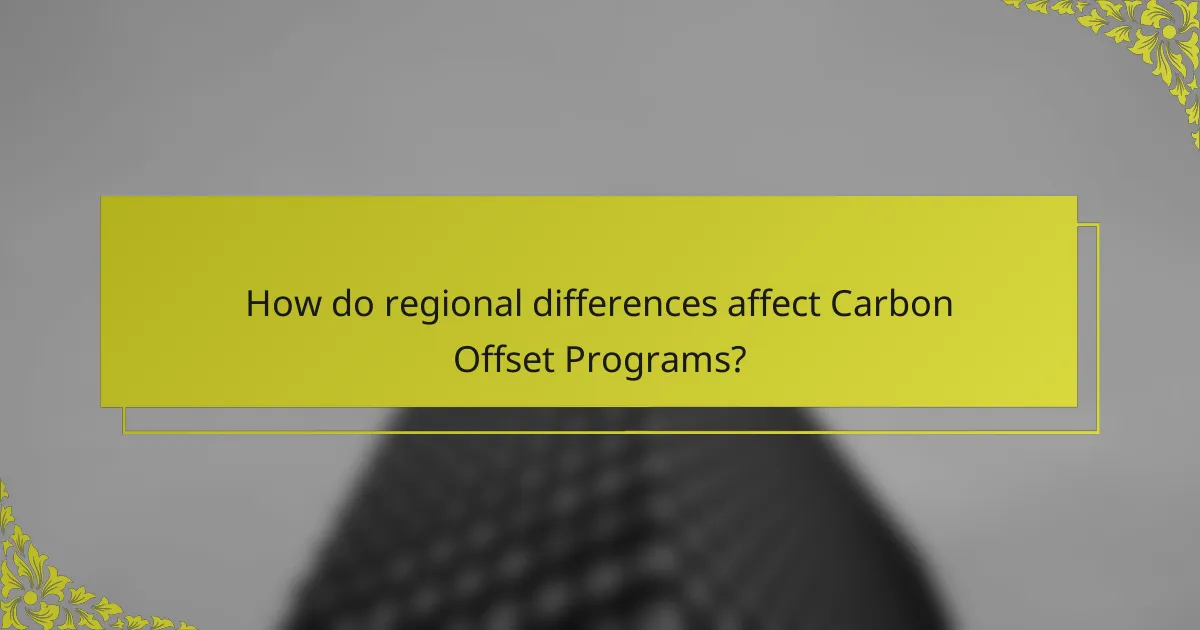
How do regional differences affect Carbon Offset Programs?
Regional differences significantly impact carbon offset programs by influencing regulations, project types, and community engagement. Variations in local environmental policies shape how these programs are implemented. For instance, some regions may prioritize reforestation, while others focus on renewable energy projects. Additionally, cultural attitudes towards climate action can affect participation levels. Regions with strong environmental movements often see higher engagement in carbon offset initiatives. Consequently, understanding these regional nuances is crucial for developing effective and tailored carbon offset strategies.
What variations in Carbon Offset participation exist across different countries?
Carbon offset participation varies significantly across countries due to regulatory frameworks, public awareness, and economic factors. Developed nations often have structured programs, while developing countries may engage in voluntary initiatives.
| Country | Participation Type | Key Features |
|——————|————————|——————————-|
| United States | Mandatory/Voluntary | Diverse market-based options |
| Germany | Mandatory | Strong regulatory support |
| Brazil | Voluntary | Focus on reforestation projects|
| India | Emerging | Government-led initiatives |
| Canada | Mandatory/Voluntary | Provincial programs available |
| Australia | Voluntary | Carbon farming opportunities |
How do cultural attitudes influence the effectiveness of Carbon Offset Programs?
Cultural attitudes significantly influence the effectiveness of Carbon Offset Programs by shaping public perception and engagement. Communities that prioritize environmental sustainability are more likely to support and participate in these initiatives. For example, in cultures where environmental awareness is high, individuals may actively seek carbon offset options, leading to greater program success. Conversely, in regions where such concerns are minimal, participation may be low, undermining overall effectiveness. Understanding these cultural nuances is crucial for tailoring programs to enhance acceptance and impact.

What are the future trends in Carbon Offset Programs?
Future trends in carbon offset programs focus on increased transparency, technology integration, and enhanced regulatory frameworks. As companies strive for sustainability, blockchain technology will provide traceability for carbon credits. Additionally, more businesses will adopt science-based targets, ensuring offsets align with actual emissions reductions. Consumer awareness will drive demand for verified and impactful projects, leading to a shift toward local and community-based initiatives. Finally, partnerships between governments and private sectors will strengthen the effectiveness of carbon offset programs, promoting broader participation and investment.
How will technology shape the evolution of Carbon Offset Programs?
Technology will significantly enhance the effectiveness and accessibility of carbon offset programs. Innovations like blockchain ensure transparency in transactions, allowing participants to track and verify their contributions. Data analytics improve project selection, identifying the most impactful initiatives. Mobile applications facilitate user engagement, making participation easier. Remote sensing technology enhances monitoring of carbon sequestration efforts, ensuring accountability. These advancements collectively foster greater public trust and participation in carbon offset initiatives.
What emerging practices are being adopted in Carbon Offset initiatives?
Carbon offset initiatives are increasingly adopting innovative practices to enhance effectiveness. These include blockchain technology for transparency, community-based projects for local engagement, and corporate partnerships to scale efforts. Additionally, integrating artificial intelligence for monitoring and reporting is becoming common.
What expert tips can enhance participation in Carbon Offset Programs?
To enhance participation in Carbon Offset Programs, focus on clear communication, community engagement, and incentivizing contributions.
First, educate potential participants about the environmental impact of their involvement. Use relatable statistics to illustrate benefits. Next, foster community through workshops and local events, promoting shared goals.
Incentives, such as rewards or recognition for contributions, can motivate individuals and businesses to join. Collaborate with local organizations to reach wider audiences and create partnerships that amplify impact.




